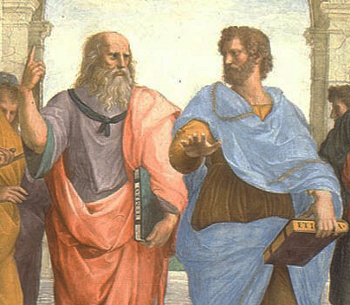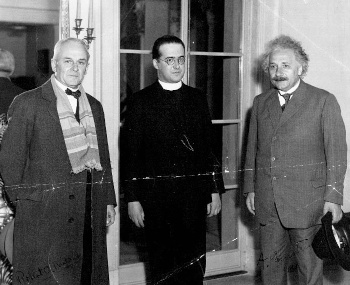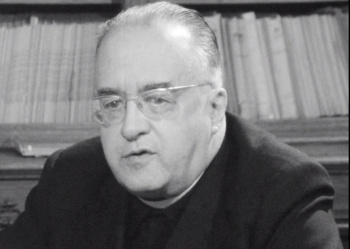Georges Lemaître
May 22, 2023
Observational science has been with us since the early
Greek philosophers, but
experimental science began with
Galileo Galilei (1564-1642) and such
novel experiments as his using
balls rolling down
inclined planes to
measure gravitational acceleration. The
Roman Catholic Church in Galileo's time had for three
centuries embraced the teachings of
Aristotle (384-322 BC), and this caused it to reject many of Galileo's
beliefs and
discoveries.
It seems strange that the
pagan, Aristotle, would have such an influence on the Church.
Thomas Aquinas (1225-1274), a
Dominican,
friar and
priest, and subsequent
saint (1323), was responsible for Aristotle's influence on the church. Thomas had great
esteem for Aristotle, and his efforts to
harmonize Aristotle's ideas with
Christian theology became a movement called
Scholasticism. As a consequence, all of Aristotle's ideas were embraced by the Church.

Plato (c.428 BC-c.348 BC), left, and Aristotle (384 BC-322 BC), from Raphael's The School of Athens.
Plato is holding his Timaeus, and Aristotle is holding his Nicomachean Ethics.
Aristotle was a student of Plato.
(Portion of a Wikimedia Commons image.)
Aristotle believed in a
geocentric universe with
Earth at its center. As a consequence, the
heliocentric universe of
Nicholas Copernicus (1473-1543) was
anathema. In 1616, the Church
banned Copernicus' 1543
book,
De revolutionibus orbium coelestium (On the Revolutions of the Celestial Spheres). Galileo ran afoul of the Church with publication of his 1632 book,
Dialogue Concerning the Two Chief World Systems that gave credence to heliocentrism.[1-2]
In 1633, this book was placed on the
Index of Forbidden Books, and it wasn't removed until 1835. Because of
ill health and
advanced age, Galileo was
sentenced to
villa arrest, and he
died in 1642.[1] Although not a reason for his
imprisonment, Galileo's
telescopic observations of the
Moon that revealed
imperfections in the
heavens above were likewise contrary to Aristotle's ideas. Centuries later, in 1992,
Pope John Paul II declared the validity of heliocentrism, and he subsequently
apologized for the Church's treatment of Galileo.
While the Church had a problem with such interpretations of
astronomical observations, it supported such observations for the reason that the
dates of
movable feasts, such as
Easter, are determined by the
phase of the Moon. The
Vatican Observatory (Specola Vaticana), the latest in a long line of Church observatories, was established at the
Vatican in 1891, and it was among the most notable observatories of the world. After forty years, it was moved as a consequence of the increasing
light pollution in
Rome to
Castel Gandolfo, a
town 16
miles (25
kilometers)
southeast of Rome. Castel Gandolfo began to have similar problems; and, in 1961, the
Vatican Observatory Research Group (VORG) was established at
Steward Observatory of the
University of Arizona (Tucson, Arizona).
Despite all the motion in the
Solar System, the
stars of the
night sky were presumed to just sit where they were created, giving rise to the terminology,
fixed stars. In 1718, however,
English astronomer,
Edmond Halley (1656-1741), discovered the
proper motion of stars when he noticed that
Aldebaran,
Arcturus, and
Sirius were quite noticeably away from the positions measured by the ancient Greek astronomer,
Hipparchus (c.190-c.120 BC).
While proper motion did not cause too much excitement in astronomical circles, another motion did. That was the
expansion of the universe, discovered by
American astronomer,
Edwin Hubble (1889-1953). This expansion is
quantified in the
eponymous Hubble's law, which expresses the
rate of this expansion, the
Hubble constant.
While Hubble is
renowned for discovery of universal expansion,
Belgian priest and
astronomer,
Georges Lemaître (1894-1966), discovered Hubble's law before Hubble.[3] Unfortunately, Lemaître's 1927
paper on this idea was
published in
French in a lesser known
journal where it was ignored.[3] As I wrote in a
previous article (Hubble and His Law, July 31, 2013), noted astronomer,
Virginia Trimble (b. 1943), listed quite a few
precursors other than Lemaître to Hubble's law in an
arXiv article.[4]

Georges Lemaître (1894-1966), center, with Robert A. Millikan (1868-1953), left, and Albert Einstein (1879-1955), right.
Einstein and Millikin were both Nobel Physics Laureates. Millikan received the Nobel Prize in Physics in 1923 for his 1909 oil drop experiment in which he measured the charge of the electron, which is the elementary electric charge.
(Wikimedia Commons image. Click for larger image.)
If the universe is expanding, there's the simple idea that we can
extrapolate backwards in time to a point of
creation. Lemaître was the first to propose the notion that the universe started in a
Big Bang in a
letter to
Nature on May 9, 1931.[6] The letter
speculated that the entire
mass of the universe was initially contained in an "atom" of
chaotic material.[5] As Lemaître wrote,
"We could conceive the beginning of the universe in the form of a unique atom, the atomic weight of which is the total mass of the universe ... [and which] would divide in smaller and smaller atoms by a kind of super-radioactive process."[5]
As noted by
Danish science historian,
Helge Kragh (b. 1944), Lemaître's atom was
matter that was undifferentiated and devoid of
physical properties.[5] Kragh also notes that Lemaître, who was writing for a scientific audience, makes it clear that his
theory was about the
origin of the universe, and not its
creation. As Lemaître wrote, "The question if it was really a beginning or rather a creation, something starting from nothing, is a
philosophical question which cannot be settled by physical or astronomical considerations."[5]
There's renewed interest in Lemaître after the discovery of a supposedly lost 1964
video interview with him by the
Vlaamse Radio- en Televisieomroeporganisatie (VRT), the
national public-service broadcaster for the
Flemish Community of Belgium.[7-9] An
arXiv posting at the end of last year provides an
English translation of the interview.[7]

Georges Lemaître during the 1964 video interview with him by the Vlaamse Radio- en Televisieomroeporganisatie (VRT), the national public-service broadcaster for the Flemish Community of Belgium.
(Still image from the video of ref. 9. Click for larger image.)
Although a three minute
excerpt existed, the entire 19 minute, 47 second, interview,
broadcast on Friday, February 14, 1964, was thought to have been lost.[7] However, it was recently found to have been mislabeled and
misclassified.[7] As the
authors state in their arXiv paper, they believe that this video, done two years before his
death, is the only video interview of Georges Lemaître in existence.[7] Unfortunately, brief portions of the
audio are
unintelligible.
Since our understanding of
cosmogony has changed so much in the intervening years, the
transcript is difficult to understand. However, several of Lemaître's responses are memorable, such as this:
"When one poses the problem of the beginning of the world, one is almost always faced with a rather essential difficulty: to ask oneself, why did it begin at that moment? Why didn't it start a little earlier? And in a certain sense, why wouldn't it have started a little earlier? So it seems that any theory that involves a beginning must be unnatural."
References:
- Henry Ansgar Kelly, "Galileo's Non-Trial (1616), Pre-Trial (1632–1633), and Trial (May 10, 1633): A Review of Procedure, Featuring Routine Violations of the Forum of Conscience," Church History, vol. 85, no. 4 (December, 2016), pp. 724-761, DOI: https://doi.org/10.1017/S0009640716001190.
- Jessica Wolf, "The truth about Galileo and his conflict with the Catholic Church," UCLA Press Release, December 22, 2016 .
- Jean-Pierre Luminet, "Editorial note to "A Homogeneous Universe of Constant Mass and Increasing Radius accounting for the Radial Velocity of Extra--Galactic Nebulae" by Georges Lemaître (1927)," arXiv, May 28, 2013.
- Virginia Trimble, "Anybody but Hubble!" arXiv, July 8, 2013.
- Helge Kragh, "Cosmology and the Origin of the Universe: Historical and Conceptual Perspectives," arXiv, June 2, 2017.
- G. Lemaîum;tre, "The beginning of the world from the point of view of quantum theory," Nature, vol. 127 (May 9, 1931), p. 706, https://doi.org/10.1038/127706b0.
- Satya Gontcho A Gontcho, Jean-Baptiste Kikwaya Eluo, and Paul Gabor, "Resurfaced 1964 VRT video interview of Georges Lemaître," arXiv, January 19, 2023, https://doi.org/10.48550/arXiv.2301.07198.
- Katherine Wright, "A Rare Glimpse into a Bygone Era," Physics, vol. 16, no. 67 (April 21, 2023).
- Eric Steffens, "Conservé. A présent, l'intégralité de l'interview d'une durée de 20 minutes a été retrouvée," VRT, December 31, 2022.
Linked Keywords: Observational science; Ancient Greek philosophy; Greek philosopher; experiment; experimental; science; Galileo Galilei (1564-1642); Galileo falling body experiments; ball; rolling; inclined plane; measurement; measure; gravitational acceleration; Roman Catholic Church; century; centuries; Aristotle (384-322 BC); belief; scientific discoveries; paganism; pagan; Thomas Aquinas (1225-1274); Dominican Order; friar; Catholic priest; saint; esteem; harmonize; Christian theology; Scholasticism; Plato (c.428 BC-c.348 BC); Raphael; The School of Athens; Timaeus (dialogue); Nicomachean Ethics; Wikimedia Commons; geocentric model; geocentric universe<; Earth; Copernican heliocentrism; heliocentric universe; Nicholas Copernicus (1473-1543); anathema; ban (law); book; De revolutionibus orbium coelestium (On the Revolutions of the Celestial Spheres); Dialogue Concerning the Two Chief World Systems; Index Librorum Prohibitorum; Index of Forbidden Books; disease; ill health; old age; advanced age; sentence (law); sentenced; house arrest; villa arrest; death; died; imprisonment; telescope; telescopic; Moon; defect; imperfection; celestial sphere; heavens above; Pope John Paul II; apology (act); apologize; astronomy; astronomical; calendar date; movable feast; Easter; lunisolar calendar; phase of the Moon; Vatican Observatory (Specola Vaticana); Vatican City; light pollution; Rome; Castel Gandolfo; town; mile; kilometer; compass point; southeast; Vatican Observatory Research Group (VORG); Steward Observatory; University of Arizona (Tucson, Arizona); Solar System; stars; night sky; fixed stars; England; English; astronomer; Edmond Halley (1656-1741); proper motion of stars; Aldebaran; Arcturus; Sirius; Hipparchus (c.190-c.120 BC); metric expansion of space; expansion of the universe; American; Edwin Hubble (1889-1953); quantification (science); quantify; eponym; eponymous; Hubble's law; rate (mathematics); Hubble constant; celebrity; renown; Belgian; Georges Lemaître (1894-1966); scientific literature; paper; publish; French language; scientific journal; Virginia Trimble (b. 1943); precursor; arXiv; Robert A. Millikan (1868-1953); Albert Einstein (1879-1955); Nobel Physics Laureate; Nobel Prize in Physics; oil drop experiment; electric charge; electron; elementary electric charge; extrapolation; extrapolate; chronology of the universe; creation; letter to the editor; Nature (journal); speculative reason; speculate; mass; chaos; chaotic; material; atom; atomic weight; mass of the universe; radioactive decay; radioactive process; Denmark; Danish; historian of science; science historian; Helge Kragh (b. 1944); matter; physical properties; theory; Creatio ex nihilo; creation; philosophy; philosophical; video; interview; Vlaamse Radio- en Televisieomroeporganisatie (VRT); state media; national public-service broadcaster; Flemish Community of Belgium; English language; translation; excerpt; broadcasting; broadcast; categorization; misclassified; author; audio signal; unintelligible; cosmogony; nature; unnatural.